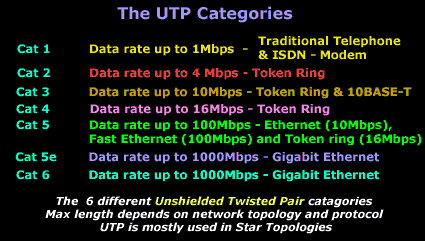Unshielded
Twisted Pair
Introduction
Unshielded Twisted Pair
cable is most certainly by far the most popular
cable around the world. UTP cable is used not only
for networking but also for the traditional
telephone (UTP-Cat 1). There are 6 different types
of UTP categories and, depending on what you want to
achieve, you would need the appropriate type of
cable. UTP-CAT5 is the most popular UTP cable, it
came to replace the good old coaxial cable which was
not able to keep up with the constant growing need
for faster and more reliable networks.
Characteristics
The characteristics of UTP are very good and make it
easy to work with, install, expand and troubleshoot
and we are going to look at the different wiring
schemes available for UTP, how to create a straight
through UTP cable, rules for safe operation and a
lot of other cool stuff !
So let's have a quick look at each of the UTP
categories available today:

Category 1/2/3/4/5/6 – a specification for the type
of copper wire (most telephone and network wire is
copper) and jacks. The number (1, 3, 5, etc) refers
to the revision of the specification and in
practical terms refers to the number of twists
inside the wire (or the quality of connection in a
jack).
CAT1
is
typically telephone wire. This type of wire is not
capable of supporting computer network traffic and
is not twisted. It is also used by phone companies
who provide ISDN, where the wiring between the
customer's site and the phone company's network uses
CAT 1
cable.
CAT2,
CAT3,
CAT4,
CAT5 and CAT6
are
network wire specifications. This type of wire can
support computer network and telephone traffic.
CAT2
is used mostly for token ring
networks, supporting speeds up to 4 Mbps. For higher
network speeds (100Mbps plus) you must use
CAT5
wire, but for 10Mbps
CAT3
will suffice.
CAT3,
CAT4 and
CAT5
cable are actually 4 pairs of
twisted copper wires and
CAT5
has more twists per inch than
CAT3
therefore can run at higher
speeds and greater lengths. The "twist" effect of
each pair in the cables will cause any interference
presented/picked up on one cable to be cancelled out
by the cable's partner which twists around the
initial cable.
CAT3 and
CAT4
are both used for Token Ring and have a maximum
length of 100 meters.
CAT6
wire was originally designed
to support gigabit
Ethernet (although
there are standards that will allow gigabit
transmission over CAT5
wire, that's
CAT 5e).
It is similar to CAT5 wire, but contains a physical
separator between the 4 pairs to further reduce
electromagnetic interference.
The next pages (check menu) show you how UTP cable
is wired and the different wiring schemes. It's well
worth visiting and reading about. |
